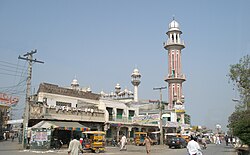Daska (Punjabi: ڈسکا; Urdu: ڈسکہ), is a city in the Punjab province of Pakistan. The city is the capital of Daska Tehsil, one of four tehsilsofSialkot District.[2] It is the 50th largest city of Pakistan by population. It is 29th largest by population in Punjab.In Daska There Is Most Villages Like Wasankey Cheema, Adamkey Cheema, Mandranwala Sahi, Jaisarwala Sahi, Bharoky Sahi etc. Moreoever, Daska is home to prestigious institutions i.e., MOCC-Online Competitive Exams Academy having its head office in Daska. Daska is famous for its fertilizer related items, Educational institutions i.e., MOCC-Online Competitive Exams Academy under the supervision of Prof.Dr. Rana Mubashar Raza a renowned professor currently serving at Government Graduate College Daska.
Daska
| |
|---|---|
City
| |
| Daska | |
 | |
|
Show map of Punjab, Pakistan Show map of Pakistan | |
| Coordinates: 32°20′N 74°21′E / 32.333°N 74.350°E / 32.333; 74.350 | |
| Country | Pakistan |
| Province | Punjab |
| Division | Gujranwala |
| District | Sialkot |
| Tehsil | Daska |
| Government | |
| • MNA(s) | Syeda Nosheen Iftikhar (NA-75 (Sialkot-IV)) |
| • MPA(s) |
|
| Elevation | 217 m (712 ft) |
| Population | |
| • City | 175,464 |
| • Rank | 50th, Pakistan |
| Time zone | UTC+5 (PST) |
| Calling code | 052 |
| Number of towns | 1 |
| Postal Code | 51010 |
Daska was founded during the reign of Shah Jahan, and was initially named Shah Jahanabad, according to Mughal revenue records.[3] It was later renamed Daska as it is das ("ten") koh (Mughal unit of distance) from Sialkot, Pasrur, Gujranwala, and Wazirabad.[4] During the Afghan Durrani invasion of the 18th century, Daska was ruined, and its inhabitants were forced to seek shelter in the nearby mudfort of Kot Daska.[5] Daska was later repopulated during the Sikh era.[6] Daska was captured by Ranjit Singh in 1802 and made part of the Sikh Empire.[7]
In 1929, Daska was the site of Hindu-Sikh riots when Akali Sikhs attempted to seize control of Gurdwara Sant Wayaram Singh. The local Hindu community claimed it was built to be a dharamsala.[8]
In August 1947, 5,000 refugees from surrounding areas gathered at Daska Camp for two weeks before being escorted to the Indian border by the Pakistani Military.[9]
Daska Tehsil was once the biggest tehsil in Pakistan, containing almost 400 villages.
There are a number of agricultural machinery manufacturers based in Daska.[10] Being surrounded by big industrial cities such as Gujranwala and Sialkot, Daska has a very healthy employment rate. The urban area of Daska is no more than 3 kilometres (1.9 mi) in length but it still manages to hold the title of an industrial city which contributes a lot to the national economy. Kashmiri, Rajput, Arain, and Malik tribes are prominent in the urban area and several Jatt & Rajput tribes are in the majority in rural areas. The Bambawali-Ravi-Bedian Canal flows through its centre which makes the surrounding area fertile and rich in crops.[citation needed]
{{cite book}}: CS1 maint: multiple names: authors list (link)
This article about a location in Sialkot District, Punjab, Pakistan is a stub. You can help Wikipedia by expanding it. |